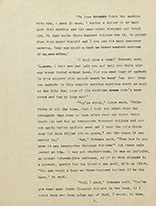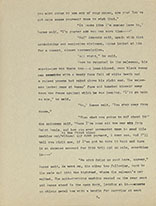Manuscripts Etc.
| CLOSE WINDOW |

|
The following items are drawn from the William Faulkner Foundation Collection at the University of Virginia's Albert and Shirley Small Special Collections Library (http://small.library.virginia.edu/). |
|
Faulkner's need for money was particularly acute in February, 1940, so the fact that Collier's magazine had bought "A Point of Law" at the end of January helped him decide to write another story "with material linked to" it, as Joseph Blotner puts it in his biography. This is that story, and the main link is the character of Lucas Beauchamp, who appears again as an essentially comic schemer whose plans often overreach themselves. As in the earlier story, here Lucas speaks with a much thicker black dialect than in the revision of the story that will appear in "The Fire and the Hearth" section of Go Down, Moses (1942). "He done fotch the machine with him. I seed it work" - on page 2 of the 19-page typescript below center - is revised as "He brought it with him. I saw with my own eyes" in the novel. (Note that Faulkner had originally typed "brought" before x'ing it out and replacing it with "fotch" in this typescript.) But if his voice keeps Lucas close to kind of stereotypical black who had amused white audiences for generations, the story opens with the white salesman whom he fools recognizing the "dignity" and "command" in Lucas' demeanor (below left). On the other hand, the character of George, with his "face full of white teeth" and "ruined panama hat raked above his right ear" (below right) remains entirely within the racial profile first popularized by the minstrel show.    As so often in his fiction, Faulkner struggles in the typescript to find the appropriate way to characterize a black man. Particularly interesting in this respect is the last, cancelled paragraph on page 4 (below left), where Lucas' face is that of a "very dark Arab." Also noteworthy is the cancelled passage on page 6 (below right), where a white man asks the two Negroes who are helping him track a mule thief whether the human footprints they are following are "a white man's" - and one of them confidently announces that "Hit's a nigger foot." In Faulkner's revision, the blacks recognize the individual who made the prints, but no mention is made of how feet might be identified racially.    One other point worth making here is prompted by the three different ways in this one typescript Faulkner thought about beginning the story's section "2" (pages 5-6, above center and right). In the Faulkner Foundation Collection are five more incomplete and unnumbered pages of drafts for "Gold Is Not Always," on which are 9 various versions of this same passage, alternative wordings for the opening of section "2." These pages remind us that even though thousands of pages of Faulkner manuscripts and typescripts still exist in different collections, there probably are even more that no longer exist: repeated drafts that were discarded as Faulkner wrote his fictions. What's gone is a major theme of Faulkner's art. The parts of Faulkner's creative ferment that we can't see testify as powerfully as the drafts we do have about how hard Faulkner almost always worked at his craft - even when the need to write something to sell to the magazines was urgent. Citing this source:
|
